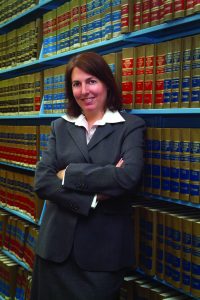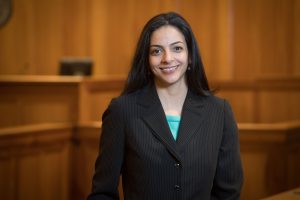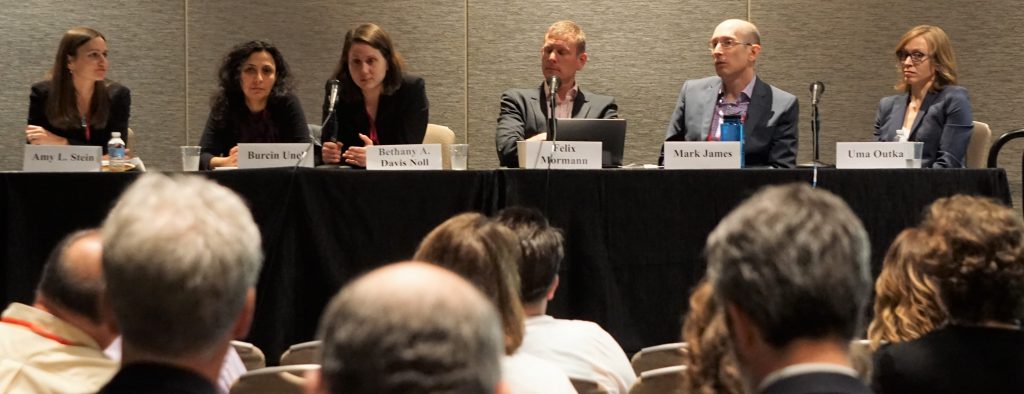The Section on Environmental Law promotes the communication of ideas, interests, and activities among members and makes recommendations on matters of interest in the teaching and improvement of the law relating to natural resources and the environment.
Chair: Kalyani Robbins, Florida International University College of Law
Chair-elect: Sharmila Murthy, Suffolk University Law School
 Kalyani Robbins, Florida International University College of Law. Photo courtesy of Florida International University College of Law
Kalyani Robbins, Florida International University College of Law. Photo courtesy of Florida International University College of Law Sharmila Murthy, Suffolk University Law School. Photo courtesy of Suffolk University School of Law.
Sharmila Murthy, Suffolk University Law School. Photo courtesy of Suffolk University School of Law.
What can you tell us about the membership of the Section on Environmental Law and the work you do?
Sharmila Murthy: Our section has a mix of participants—many are doctrinal professors, but we also have people who are involved in clinics and even fellows or visiting assistant professors who are aspiring to become faculty. Speaking as someone who is still a junior faculty member, the section is quite supportive. Sometimes, even the opportunity to sit next to someone on the way to a field trip and informally build a relationship allows members feel more comfortable participating in the section.
Kalyani Robbins: In terms of what we teach, almost everyone teaches the basic survey course because in most cases their school is not focused on environmental law. It’s rare for faculty at law schools without a focus on environmental law to teach more than two environmental courses, and one was always the environmental law survey course.
At our AALS Midyear Meeting in 2012, several colleagues and I presented a panel called “Generations of Environmental Law,” which included data from every law school in the country on which professors identified as environmental law professors, what they did, what subject areas they focused on, and how many of them were at their school. Some schools didn’t have any, and the majority of law schools had only one.
Several law schools have larger programs in environmental and natural resources law and have multiple law professors in the area. Those faculty were able to teach more and a wider variety of environmental and natural resources law courses.
SM: The field trips at the Annual Meeting really enhance our section. I was eager to get involved in the section in part because of the connections I’ve made while on the field trips. Environmental law as a topic is particularly relevant in the real world. You need to understand the science, and you need to understand the place. It’s very interdisciplinary, and we have these great opportunities to actually go and observe what’s happening in a particular locality where we’re having the conference.
KR: It mirrors what we do outside of AALS. We have a very friendly group and we want to spend time together both as friends and to discuss the important issues in our scholarship that are affecting the planet right now. I think our section is especially engaged with one another and we schedule multiple opportunities to spend time together at the AALS Annual Meeting. We take a lot of interest in each other’s work and give each other feedback, mentorship, and friendship.
This summer has been full of topical environmental news, from local plastic straw bans to the Trump administration seeking to revoke California’s authority to regulate automobile emissions. How do you see some of these issues playing out on the local and national level?
KR: This is why it’s important for our membership to stay engaged in the real world. If we hide in the ivory tower talking about abstract concepts and don’t engage the real world, we could sustain serious losses in our natural resources and general environmental safety and protection.
SM: What we’re seeing happening today is a reminder of how important the natural environment is. We all want clean air to breathe and we want an earth for our children to live in. Right now, people recognize that we need to take action at all levels. At the national level, we are seeing a rollback of some hallmark environmental protections, despite the fact that many of our statues were passed with bipartisan support and under administrations of both parties. Environmental protection was historically a bipartisan issue, but has increasingly become a partisan issue.
“Environmental protection was historically a bipartisan issue, but has increasingly become a partisan issue.” – Sharmila Murthy
There’s a whole body of work around private environmental governance. The law is slowly changing, but other actors are stepping up to fill the current void. Even in international environmental law—for example, President Trump announced he wants to withdraw the U.S. from the Paris Agreement on climate change. Now we see cities, states, corporations, and NGOs pledging to uphold the goals of the agreement.
How has the conversation around environmental law changed in response to the current administration (or how do you anticipate it will change)?
KR: From my perspective, it has become less relaxed and more dire. People are becoming more creative to solve problems without depending on national leadership—for example, a symposium I put together last October focused on federalism and how states, municipalities, and private actors might fill in that gap.
SM: Many of us are looking at how can we contribute. The Environmental Law listserv recently called everyone to action to say we need to take our ideas out of the ivory tower, write op-eds, and get ideas out there. Although there is an incredibly important place for scholarly discourse, we also want to translate those ideas out into the real world. I am involved on the board of the Conservation Law Foundation here in Massachusetts, and I’m trying to share some of my work with them as they actively think about various strategies, whether it be about drinking water or climate change or other pressing issues of the day. People in our section are very active in writing amicus briefs, contributing op-eds, being engaged with NGOs, and so on.
What are the other important conversations happening right now regarding environmental law?
KR: Thinking in terms of the biggest impact for the whole planet, climate change and biodiversity are the top two concerns. All the issues are so important—we could look at climate change, which affects everyone, but that doesn’t mean we are not also concerned about the planet’s water crisis. In this field, there are many serious issues, on many different scales, at all times.
SM: The reality of environmental law is that we haven’t had any recent big legislation. The current challenge is that so much is happening administratively. Take something like climate change: Domestically, the Obama administration was trying to expand the interpretation of the Clean Air Act. If we didn’t have gridlock in Congress, we could think about legislation. Instead we’re looking to the courts. A lot of creative lawsuits are being developed, because we haven’t had the statutory solution that would address a lot of these problems.
This has also highlighted the need to build coalitions with other groups. For example, our panel [at the Annual Meeting] this coming year is co-sponsored with the Sections on Minority Groups and State and Local Government, and looks at disasters. One of the key points is that environmental issues are not just issues for people who have the ability to buy expensive backpacks and go trekking in some far-off place. These issues are affecting everybody. Some of the extreme weather patterns we’re experiencing are disproportionately impacting marginalized communities. The lead crisis in Flint is a telling example of the growing divides in our population. Those who have the least are bearing the brunt of many of the environmental impacts.
Professor Robbins, you did a Hot Topic session at the 2018 Annual Meeting about creative lawsuits, correct?
KR: Yes, I proposed and presented “Juliana v. United States Atmospheric Trust Litigation: Will the Children Save the Planet?” I’ve been involved in that case from a distance. It’s fascinating. Even if it doesn’t make it all the way, the facts that it’s generating and the opinions that are coming out below are providing useful guidance for other cases in the future.
The plaintiffs are saying two things: one, that the atmosphere is in the public trust. The government has a trust duty to protect the atmosphere for all who are interested in it (which is everyone) but especially for young people, who would be most impacted by a decline in air quality. The public trust argument has been made in other states to mixed response.
The other, more novel, argument is constitutional. They’re saying they are being deprived of life, liberty, and property by the failure to protect them from the impact of climate change, and that the government has a duty to protect them arising out of the government’s own actions that made things worse—particularly subsidizing the fossil fuel industry when documents dating back into the 1950s show knowledge of the impact of fossil fuels on climate. The government, with knowledge, contributed to the danger and therefore has a responsibility to protect them from the harm. Policies are failing to do so, and therefore need to be changed.
What are some conversations happening right now in legal education about teaching environmental law?
SM: I usually tell students on the first day that they don’t want to take my class, and it shocks them. I say “you think you’re coming in to learn about saving whales and bunnies but in reality—” then I hold up this massive statutory book of selective environmental statutes. It is an incredibly dense course, and the statutes and the cases can be very challenging to teach students. The task we have as educators is to see the potential for transformative change and to see the way in which these statues can be used for the public good even though it can be difficult to learn.
KR: Our colleagues care deeply about sharing strategies for teaching and planning courses. That happens in two places. The first is at the Natural Resources Law Teachers Institute, which is well-attended and where we always have one evening meeting to talk about teaching environmental law. The other place is on the listserv that Sharmila mentioned. People will simply ask for resources, and we exchange a lot of ideas about teaching methods, class exercises, and field trips. We really engage with each other.
SM: There was a lively debate on the listserv recently about the best way to have a formative assessment, whether it was the classic exam, essay, skills-based learning, or having practical exercises. I have found that people are very willing to share their experiences and their materials.
“The task we have as educators is to see the potential for transformative change…” – Sharmila Murthy
How else does your section interact and collaborate outside of the Annual Meeting?
KR: We have several main events. There’s the Rocky Mountain Mineral Law Foundation’s Natural Resources Law Teachers Institute, held every other year, which is huge. Vermont Law School puts on an environmental law scholarship colloquium every fall that includes a full day of worksin-progress. We also have been participating more in the Association for Law, Property and Society, which has an annual meeting at the beginning of the summer each year. Some of those are in the U.S., and some are abroad. There’s also a fairly new annual meeting at Arizona State University.
SM: One other event is the Sabin Colloquium on Innovative Environmental Scholarship, which is for junior faculty and a couple of invited senior commentators.
How does your section support the scholarship of your members?
KR: There are around 500 environmental law professors nationwide. This year we and the Sections on Natural Resources and on Agriculture are putting on a works-in-progress session that will include scholars with their work and commentators who will give feedback. And the Vermont Law School colloquium is the regular form of that, although it’s not our section per se. It’s still our colleagues.
Do you have any programs to support the mentorship of junior faculty?
KR: We value and make clear that it’s important to us, culturally, to have junior faculty feel included both socially and in discussions about scholarship. When a senior faculty member is especially good at mentoring junior faculty members, they’re praised for that that in our section. I also try to schedule an informal networking meal at the AALS Annual Meeting.
SM: From my own personal perspective, I do think that the field trips, works-in-progress sessions, and junior scholar workshops do a good job of looking at the larger pipeline and mentoring people who would like to become environmental law professors. In addition, Pace Law School holds a Future Environmental Law Professors Workshop.
Your section was formed in the early 1970s. What improvements to law school curricula have happened since then?
KR: The early 1970s is not just when the section was formed, it’s also when U.S. environmental law was formed. It’s fascinating that it happened that quickly—most environmental statutes are from that same time.
I am one decade into being a law professor. It’s hard for me to speak to the long-term progression of curriculum. I imagine that when it was newer, the focus was on all of the new legislative developments. Over time, it has gradually shifted to focus more on case law.
SM: I suspect that like all legal education there’s been a rise in clinics and a rise in, at least on the scholarly side, using empirical methods and different approaches to learning.
KR: One approach that I’m shifting toward with my own environmental law classes, that I think takes time to develop, is stories. Over the years there are more and more big stories. This fall, I’m going to reduce the breadth of the course I teach, cover fewer statutes, and focus more on interdisciplinary concepts and stories. There are so many interesting ones that help us see the impact of environmental law on all of our lives. I think the option to approach the course from that perspective took decades to develop.
SM: Although we’re talking about environmental law, we have a whole other vocabulary that people are using to reflect the interdisciplinary nature of the issues—like sustainability, resilience, and sustainable development. Environmental law is just one facet of a much broader set of complicated issues.
Could you give more detail about what you have planned for the 2019 Annual Meeting?
KR: Our section has a lot of going on this year. We have the joint field trip with the Sections on Natural Resources and Energy Law and Agriculture and Food Law. We’re really trying to take advantage of the city itself and focus on some of the dangers faced in certain parts of the city due to sea level rise and levee issues.
Our main panel is with the Sections on Minority Groups and State and Local Government, which are new sections to us. It will focus on the disparate impact of disasters on the environments of marginalized people and their need for a stronger political voice.
That’s about how much we normally do, but this year we’re also adding a works-in-progress session. That’s an exciting opportunity to talk about our scholarship, mentor junior scholars, and bring ourselves together. Informally, we’re also doing a brewery tour after the field trip—you can call that networking.
What is your vision for the section, this year and in the years to come? What new initiatives, project-based or ongoing, would you like to see as part of the section?
SM: First, I’d like to keep up the great work we’re already doing. I think there are additional opportunities to co-sponsor or develop relationships with other sections.
We are extremely active as a community at various events throughout the country, but AALS and this section always provide an opportunity to centralize and build on those efforts. People will be thinking about the election in 2020, and we’ll have a host of exciting issues to talk about.
 Environmental Law co-sponsored panel at the 2018 Annual Meeting
Environmental Law co-sponsored panel at the 2018 Annual Meeting